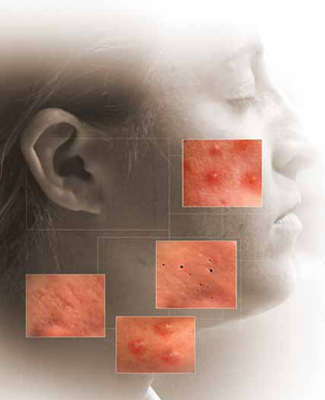• Use a classification system, such as that of the American Academy of Dermatology, to assess the severity of acne vulgaris. A
• Treat inflammatory lesions aggressively to prevent scarring. A
• When isotretinoin is indicated, consider prescribing a lower dosage (but longer duration) than the traditional regimen. B
Strength of recommendation (SOR)
A Good-quality patient-oriented evidence
B Inconsistent or limited-quality patient-oriented evidence
C Consensus, usual practice, opinion, disease-oriented evidence, case series
CASE Janis S, an otherwise healthy 19-year-old, is in your office, seeking treatment for acne. She reports she has tried various over-the-counter (OTC) creams in recent months, but has seen little improvement. The acne first appeared about 5 years ago, and her pediatrician prescribed topical adapalene and doxycycline. The treatment helped, but she says her face never fully cleared up; over the past year, the acne has gotten worse.
On examination, you find several nodules and comedones on the patient’s face, chest, and back. Ms. S confides in you that the acne—particularly on her face—kept her from going to the senior prom.
More than 80% of adolescents and adults develop acne vulgaris at some point in their lives, and in at least 15% to 20% of cases, the acne is moderate to severe.1 Although acne typically starts in early puberty, it can continue well into adulthood.2 Females typically develop acne at an earlier age than males. There are no other sex or racial differences.3
Regardless of the age at which acne develops, it has substantial psychological effects, including embarrassment, shame, depression, anxiety, social isolation—and in extreme cases, suicidal ideation.4 This evidence-based update will better prepare you to provide optimal medical therapy—and alleviate patients’ emotional distress—without delay.
The pathophysiology of acne vulgaris
The American Academy of Dermatology (AAD) defines acne as a “chronic inflammatory dermatosis which is notable for open and/or closed comedones (blackheads and whiteheads) and inflammatory lesions, including papules, pustules, and nodules….”5 The underlying etiology is best described as a cascade of events involving the pilosebaceous unit.
Normally, single keratinocytes are shed into the follicular lumen for excretion. In acne, this process is disrupted and the keratinocytes accumulate, becoming interwoven with monofilaments and lipid droplets. The lipids, cellular debris, and excessive sebum, as well as the overgrowth of Propionibacterium acnes, block the follicles;6 the bacterial overgrowth can generate inflammation, as well.7 Areas rich in sebaceous glands, such as the face, neck, chest, upper arms, and back, are the sites at which acne is most likely to develop.

Clockwise, from top: closed comedones; open comedones; pustules; and scarring.
Androgen receptors play a role
For many years, the underlying pathophysiology of acne vulgaris was thought to be lesion progression, with microcomedone formation leading to both closed and open comedones. Emerging evidence has led to a deeper understanding of acne development. Sebum is now known to have androgen receptors (nuclear transcription factor Fox O1), which are modulated by insulinlike-growth factor 1 (IGF-1) and insulin.8,9 Research to determine whether these receptors can be influenced by diet and melanocortins is ongoing.8,10
Evidence has also shown that inflammation around the follicles and follicular differentiation precede bacterial overgrowth,7 and that P acnes overgrowth exacerbates the blockage and inflammation by creating a biofilm that plugs the follicles. Inflammation is one of the main complications of acne, causing hyperpigmentation and scarring.
These factors increase the risk
There are numerous risk factors for acne, ranging from genetics to stress to certain medications (TABLE 1).11 Although the exact genetic penetrance is unknown, acne often affects multiple family members;1,12 genetics is also associated with an increase in androgens, such as that found in patients with Cushing syndrome, polycystic ovary syndrome (PCOS), and congenital adrenal hyperplasia.13
Emotional and physical stress can increase the risk for acne,14 with the latter often related to excessive friction on the skin caused by sweat bands or helmet strips. Cosmetics that plug the follicles are a risk factor for acne, as well.
TABLE 1
Drugs that are potential acne triggers
| Common drugs/drug classes |
| Anabolic steroids (eg, danazol and testosterone) Bromides and iodides Corticosteroids (eg, prednisone) Corticotropin Isoniazid and ethionamide Lithium and barbiturates Phenytoin and trimethadione |
| Less common drugs |
| Azathioprine Cyclosporine Disulfiram Phenobarbital Quinidine |
| Adapted from: Sterry W, et al. Dermatology. Thieme Clinical Companions. 2006.11 |
The patient has acne, but how severe?
Because acne is often diagnosed clinically, there is often no need for routine testing. Nor is a bacterial culture for P acnes necessary.
If the patient has signs and symptoms suggestive of an endocrine disorder, however—eg, infertility, PCOS, or hirsutism—consider checking free testosterone, dehydroepiandrosterone sulfate (DHEA), luteinizing/follicle-stimulating hormones (LH/FSH), 17-alpha-progesterone, adrenocorticotropic hormone (ACTH), and/or dexamethasone suppression. Other indicators of a need for endocrine testing include male or female pattern balding, an abnormal menstrual cycle, acanthosis nigricans, and truncal obesity.5,6

